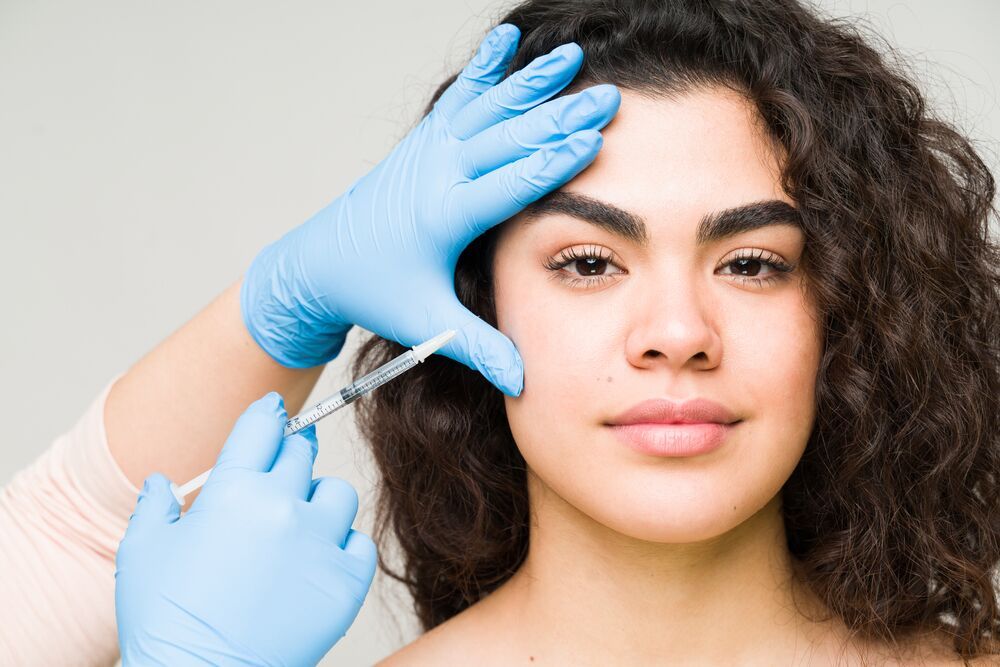Is Labiaplasty Right for You? A Guide to Costs, Benefits, and Realistic Expectations

Botox Vs Fillers: What Is The Difference?
by Dr. Sheila Nazarian

by Dr. Sheila Nazarian

Botox and fillers are cosmetic injections that are given to enhance your appearance. These injections can be given in your cosmetic provider’s office. They are both minimally invasive, which means no incisions are involved. This is about the only things that fillers and Botox have in common.
In this guide, we will discuss the difference between Botox vs fillers.
Botox is a neurotoxin derived from Clostridium botulinum, a harmless bacterium found in many natural settings such as soil, lakes, and forests. It can also be found in the intestinal tracts of mammals and fish. Neurotoxins target the nervous system.
Botox is the first FDA-approved treatment to temporarily alleviate moderate to severe frown lines, crow’s feet, and forehead lines in adults. Botox can be used to treat certain muscular conditions or as a nonsurgical cosmetic treatment because it temporarily paralyzes the targeted muscle.
Botox is a non-permanent, nonsurgical treatment that takes about 10 minutes and requires minimal downtime. Results can be seen within 1-2 weeks. The treatment delivers subtle results. The amount of Botox injected into the area of treatment can be fine-tuned to offer optimal results that can promote a more youthful and lifted appearance.
Keep reading to find out the differences of Botox Vs Fillers.
Neurotoxins are temporary muscle paralyzers or muscle relaxers. Botox is one brand of neurotoxin. There are currently four different types of neurotoxins. These brands are listed in order of strongest to gentlest: Dysport, Botox, Jeuveau, and Xeomin.
If the patient needs a lot of facial movement, doctors typically recommend Jeaveau or Xeomin. These gentle muscle relaxers allow for more facial movement. These brands are recommended to actors because they need a wide range of movement in their line of work.
The doctor will usually recommend Dysport or Botox for patients who want minimal or no movement. It is important to remember that all of these neurotoxins can be adjusted; the doctor is able to inject more or less depending on the patient.
Neurotoxins, such as Botox, don’t add volume because they only affect the muscle activity. Unlike fillers, neurotoxins are not volumizers. Instead, they simply relax the muscle. They are non-permanent and results typically last between three to four months. Patients must be reinjected to continue to see results.
The most commonly targeted areas of Botox are the face and neck. Botox can also be injected into areas of the body to treat symptoms other than wrinkles. Some doctors use Botox to treat certain muscular conditions such as uncontrollable muscle spasms or excessive sweating in the armpit area or hands.
The ideal candidate for Botox is someone who wants to treat moderate to severe wrinkles or certain muscular conditions. The patient may be a good fit for Botox if they are unhappy with the appearance of wrinkles, are generally in good health, and have realistic expectations for results.
The patient may not be a good fit for Botox if they are allergic to certain neurotoxins, have a skin infection, are pregnant or breastfeeding, or have a severe muscle or nerve condition. Prior to the procedure, the patient will schedule a consultation with their doctor to determine the right course of treatment for them based on their needs and goals.
Pros:
Cons:
It is important to set up a consultation with a qualified doctor to express any concerns you have regarding the procedure.
Dermal fillers may also be referred to as soft tissue fillers or just fillers. They are designed to be injected beneath the skin’s surface to help add volume and fullness. Like neurotoxins, fillers are non-permanent and non-invasive. Fillers are different from neurotoxins because they work to add volume to the treatment area that is injected. There are different types of fillers that can help patients depending on their goals.
There are many types of fillers out on the market. It is important for patients to consult with a doctor who has knowledge and experience. Fillers that are not injected correctly will result in an over-the-top voluminous look.
One of the latest trends is injecting Sculptra, Radiesse, and Renuva fillers to create long-lasting volume in liposuction divots or buttocks.
Each type of filler is designed to help treat a different sign of aging or cosmetic issue. How long it will take to work and how long it will last will vary among each product. It is best to consult with your cosmetic provider to discuss desired results, as they can make suggestions on which products to use.
The human body’s cells float in a jelly-like substance, known as hyaluronic acid. These fillers typically last six to 18 months. They do not last the whole time, however. Hyaluronic fillers slowly deteriorate, so it is important to get a touch-up every six to nine months, as this is the time that typically half of the filler will be gone by. Some brands of hyaluronic acid fillers include Juvaderm, Restylane, Belotero, and Voluma.
Calcium-based fillers (known as calcium hydroxylapatite) are typically thicker and last longer than hyaluronic acid fillers. These fillers last a minimum of 12 months for most patients. Research shows that calcium-based fillers may stimulate natural collagen production and are best for areas where bony enhancement is happening, like the jaw or chin. Radiesse is a popular form of calcium-based filler. It is typically recommended for areas with bone, including the jaw, chin, temple, and cheeks. This filler is best for patients who want a lot of definition. It is also FDA approved to rejuvenate the backs of the hands.
Polylactic acid fillers (PLLA) are a biodegradable synthetic substance. They promote the body’s natural collagen production. Sculptra Aesthetic is the most popular polylactic acid filler. The filler is made out of lactic acid particles. When injected into the body, collagen forms around the cells. Using these fillers is a slower process, as patients must wait for their bodies to create collagen. Some patients prefer this type of filler because it lasts longer than others. Due to the slow growth of collagen in the body, multiple treatment sessions and patients may be necessary.
Autologous fat injections use borrowed fat from a part of the patient’s body where it is not desired and placed into the face where it could use some more volume. There is also an off-the-shelf fat (commonly referred to as Renuva, it’s a brand name) that constitutes the most recent class of filler. Renuva uses cadaver fat that is irradiated, so no more live cells are in it. The only thing that remains is the structure and architecture of fat. The body will build fat and collagen where it is injected. This treatment is great for filling liposuction divots, building the buttocks, or forming fat in areas the patient wants it to grow. The results from Renuva and autologous fat may last for years and even be permanent.
Every filler is designed to target a different issue. So, it will highly depend on the filler product you choose to go with.
In general, dermal fillers are considered safe, but there is always a risk of side effects. The most common side effects may include:
Both neurotoxins and fillers can be great anti-aging tools. As we age, we lose volume. This means we lose bony volume, muscle volume, or fat. Fillers can combat aging and help patients exude a youthful, healthy appearance. Neurotoxins also help prevent wrinkles and can lift the skin. Both are given as injections and are measured out in units.
Botox will paralyze the muscle to help decrease wrinkles that may be caused by facial expressions. These wrinkles are typically found in the upper face, such as the forehead and around the eyes. Results will last up to 3 to 6 months.
Fillers use hyaluronic acid to help add volume and smooth out an area. They may be used to help decrease wrinkles around the mouth, thin lips, and help volumize cheeks that are hollow. In addition, fillers may be used on forehead wrinkles, scars and other areas that need volume or smoothed out. The results of a dermal filler vary depending on the type of filler that is used.
Both Botox and fillers are different substances, so it is possible to get a treatment that combines both. For example, you may use Botox to help correct crow’s feet, and a filler to help decrease smile lines around the mouth.
Neurotransmitters, such as Botox, do not build volume. They simply relax the injected muscles. On the other hand, fillers help build volume. Increased volume does not make you appear fatter. When used properly, it gives a more chiseled, lifted, and well-rested appearance.
If you are on the fence about the difference between Botox Vs Fillers, then it best to come in for a consultation. Dr. Nazarian can evaluate your needs and help you make a decision on which is injection is best for you!
A dermal filler is highly effective and can last up to 1.5 years, but this will highly depend on the type of filler that you choose and your own metabolism. In general, fillers last longer than Botox.
Everyone is different and that is why it is important that you schedule a consultation with your cosmetic provider. However, as a rule of thumb, lines created by expression will need to be treated with Botox. Lines that are present at rest will need a filler. Botox is ideal for crease points, while fillers work best on deep lines.
Botox relaxes the muscles while a filler can increase collagen production and helps add volume to the areas where it is placed.
Botox can last anywhere between 3 to 6 months. You will need follow up injections to maintain the results.

Despite the rise in popularity of cosmetic surgery procedures, many people still have no idea what a labiaplasty is. Let’s review if it is the right procedure for you. What is Labiaplasty? Labiaplasty is a […]

Volume loss is common as you age. As the temples lose volume, they become hollow. They make you look older and less attractive. Its effects could lead to facial imbalance, brow ptosis, and even crow’s […]

You may have hooded eyes or be wondering if you have hooded eyes. We will look at all that in this article and help you make the right choice on whether to correct it or […]